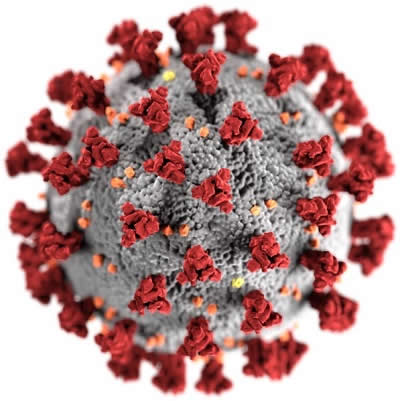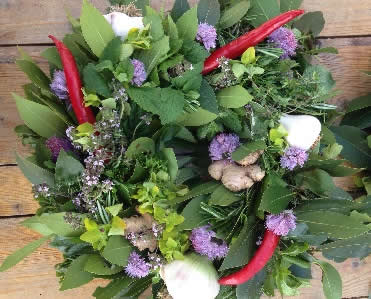Positive Health Online
Your Country

Eat for Immunity
listed in herbal medicine, originally published in issue 262 - May 2020
What strange times we are living in. 2020 has certainly been eventful and lifechanging for many people the world over. Self-isolation is a new word in my vocabulary, as is social distancing and Covid-19, the invisible ‘enemy’ that has caused pain and panic all year. In such times of uncertainty, it can be hard to know what to do to stay well and strong. When it comes to maintaining good health, the immune system is the body’s most precious asset. By helping the body to resist infection, it offers protection against disease. Yet, despite modern scientific understanding and major advances in medical treatments, infection is still the commonest cause of illness and death worldwide.
In the early 1950s, with antibiotics and general vaccination programmes moving into the medical frontline, it seemed to most people that scientific know-how was going to provide more effective solutions to disease than old-fashioned naturopathic methods designed to encourage self-healing. Now, 70 years later, we are faced with a virus that has turned society upside down from one day to the next. Unprecedented changes have been caused by this tiny invisible organism that grew out of human maltreatment of other species. Our lack of compassion and lack of ability to see that everyone has an equal right to life is having life-changing consequences on the whole human race.

https://www.kirstenhartvig.com/new-index#/naturopathy
But this situation has made us go back to basic natural healing principles, working with nature and doing everything we can to enhance our natural powers of healing and self-defence. Our focus has changed from external events to an inward-looking, broader approach to health, observing the interaction between the physical, mental, emotional and spiritual aspects of ourselves, and understanding how these affect our health and our susceptibility to disease.
We are being forced to turn our attention once again to food, clean water, and basic hygiene. Good health involves caring for body, mind and spirit, and the immune response is the fundamental physical process of healing, which is in turn affected by food and lifestyle.
The commonly-held belief that germs are malign micro-foes, constantly out to get us, and that the best way to deal with them is to zap them with increasing doses of drugs is, in fact, a misinterpretation of what the pioneers of microbiology and immunology were trying to say. Louis Pasteur, together with the other holistic medical thinkers – Antoine Béchamp, Claude Bernard and Max von Petterkofer – emphasized that microbes are only a part of the story, best thought of as agents of disease rather than its cause, their effects largely dependent on the nature of the bodily ‘terrain’ they encounter. In other words, these early researchers understood that the state of the body’s natural defence systems was paramount to the maintenance of good health.
Clinical experience and modern research show that lifestyle factors have powerful effects on immunity, particularly stress, environmental pollution, alcohol, smoking, obesity, lack of exercise, age – and of course food.
The medicinal value of plant foods and herbs for warding off illness has been acknowledged for thousands of years, and in the modern era scientific research has discovered hundreds of beneficial nutrients in the plant-based foods we eat. By applying knowledge of these nutrients and of how they work to our diet, we can eat foods that boost our immune system and so help protect ourselves against disease.
The common cold and influenza are both viral infections. Both can cause runny nose, sore throat, headache, fever and general malaise. Cold symptoms are usually mild at first and develop relatively slowly. In contrast, influenza symptoms start abruptly and include aching joints and limbs, high fever, shivering, severe headache and often a persistent dry cough. Most flu symptoms last only a few days, but the cough may persist, and depression, lethargy and tiredness often follow and may be long-lasting. Flu can be accompanied by secondary bacterial infections, particularly bronchitis or pneumonia, which take advantage of the body’s weakened state, especially among the elderly.
All influenza viruses are highly infectious and cause seasonal outbreaks of moderate to severe illness normally lasting one or two weeks. The increased international travel of modern times has allowed outbreaks to spread rapidly, increasing the risk of global pandemics.
The flu virus affects animals and birds (particularly if they are intensively reared) as well as humans and can change its form in unpredictable ways. As a result, immunity to older strains of the virus may not protect from newer, mutated strains. When a new strain crosses over from animals or birds to humans, it may spread quickly to large numbers of people.
Worldwide flu outbreaks have occurred several times in history, and on average there have been three major pandemics per century over the past 300 years. The ‘Spanish’ flu of 1918-19 killed between 20 and 50 million people. It was caused by the influenza A, H1N1 virus and was so aggressive that many people died just a few days after becoming infected. Although flu normally affects the most vulnerable (such as children and the elderly), Spanish flu also affected the strongest – nearly half the victims were young, healthy adults.
Since the Spanish flu catastrophe, there have been two major pandemics: Asian flu in 1957-58 and Swine flu in 2009.
Asian flu was caused by an A(H2N2) virus, and began in China in 1956 where it originated in wild ducks when a mutated avian flu virus combined with a human virus strain. It spread around Asia and continued to North America and the rest of the world. Although a vaccine developed in 1957 helped contain the outbreak, a further mutation of the avian flu virus (H3N2) was responsible for the milder pandemic in 1968-69 named the Hong Kong Flu. It is estimated that the two pandemics were responsible for between 1 and 4 million deaths each.
The first pandemic of the 21st century was caused by a new strain of influenza A (H1N1/09) in 2009-10. It became known swine flu, or Mexican flu, and was responsible for between 100,000 – 400,000 deaths in the first year, significantly less than earlier pandemics, perhaps because it was the first time several countries had collaborated to institute public health measures to limit illness and deaths. Children had no immunity to the new strain, but adults, particularly those over 60, were not as badly affected.
H1N1/09 proved more contagious than seasonal flu, spreading from person to person via droplets from coughs and sneezes. Those infected were contagious for several days after the fever subsided, and although the symptoms were generally quite mild compared to seasonal flu, the swine flu virus infected cells deep within the lungs, causing severe respiratory symptoms in some people, and even acute respiratory distress syndrome, which is often fatal.

https://en.wikipedia.org/wiki/File:2019-nCoV-CDC-23312_without_background.png
We are now in the midst of a new pandemic, Coronavirus disease (COVID-19) which started in Wuhan City in China in December 2019 and has since radically changed the lives of millions of people the world over. These are unprecedented times, forcing people and countries to work together, and communities to learn from and support each other across national and continental boundaries.
The medical profession and government authorities have been working all hours to keep people safe, physically and psychologically as well as financially, and we have much to be grateful to them for. To lighten their load, it is very important to take a “prevention is better than cure” attitude, doing everything possible to avoid transmission by following the official guidelines about handwashing, travel, social distancing and self-isolation, and also by maintaining a strong immune system through good diet, natural remedies and healthy lifestyle.
The natural way of increasing resistance to colds and flu is to pay attention to nutrition; manage stress levels; avoid alcohol, tobacco, recreational drugs; avoid excess sugar intake and high levels of dietary cholesterol; and avoid dehydration and over-exposure to extremes of heat or cold. Getting plenty fresh air and exercise as well as rest, and drinking enough water creates a less favourable environment for the virus and at the same time improves the function of the immune system.
Over recent decades, scientific studies have confirmed that poor nutrition impairs immune function, and that a diet based primarily on minimally processed and chemically unadulterated plant foods is the most effective way of enhancing immunity.

Fresh herb wreath with chili, bay leaf, rosemary, mint, ginger, garlic, thyme, chives, marjoram and sage
https://www.kirstenhartvig.com/new-index#/herbal-medicine
Hundreds of reliable studies show that fresh herbs, vegetables, fruits, nuts, grains and pulses are packed with immune-boosting phytochemicals. A plant-based approach is relevant to every style of eating – carnivore, pescatarian, vegetarian or vegan – because increasing your intake of health-enhancing foods and herbs leaves less space for the foods that weaken your immune response. Thanks to their high antioxidant and vitamin content, fresh fruit and vegetable juices are excellent cold and flu preventives, whilst dairy products should be avoided altogether.
Here are some Easy Recipes to Try
Cold Remedy tea mix
Infuse 1 tsp each of elderflowers and chamomile flowers in a mug of boiling water for 10 minutes. Drink freely.
Elderflowers are anti-catarrhal anti-inflammatory, and circulatory and immune stimulant. They enhance natural resistance to colds, flu and fever, as well as allergic symptoms and catarrh. Chamomile flowers are anti-inflammatory, antiseptic and sedative. They help relieve restlessness and tension and are a useful gentle aid to the immune system.
Warming detox tea mix
- 1 handful fresh nettle tips (or 1tbsp dried nettle)
- 1-2 inch cube fresh ginger, sliced
- 1-2 inch cube fresh turmeric, sliced
- ½ lemon with peel, thinly sliced
Add all the ingredients to a teapot. Fill with boiling water and infuse for 10-15 minutes, or longer. Drink freely, and you can keep adding freshly boiled water to the pot.
Nettle has a unique ability to revitalize and replenish, helping the body to cope better in difficult circumstances, and providing many of the building blocks necessary for health and healing. Nettle tea has been used for centuries as a blood purifier and ‘spring tonic’. As both a circulatory stimulant and a diuretic, it is a powerful aid to detox. Adding ginger to the mix helps stimulate peripheral circulation. It is a warming and comforting remedy for colds and chills, and it has antiseptic and detoxifying qualities. Turmeric is antimicrobial, anti-inflammatory and antioxidant, aiding immunity by enhancing the heath of the liver and mop up free radicals. Lemon contains high levels of vitamin C which boosts the body’s resistance to infection as well as enhancing iron absorption and strengthening cell membranes.
Raspberry Vinegar
- 350ml cider vinegar
- 250g raspberries
- 2 tbsp syrup.
Place all the ingredients in a stainless-steel pan over a gentle heat and warm through until the syrup is fully dissolved. Do not let the mixture boil. Strain and bottle and keep in the fridge.
Raspberries contain vitamins A and C, iron, calcium, and polyphenols that have an anti-inflammatory and antibiotic effect. Use the vinegar on salads or take a neat spoonful to help relieve symptoms of coughs, colds and flu.
Quick Tomato Soup: (serves 2)
- 500g fresh tomatoes, quartered and stalks removed
- 1-2 spring onions, finely chopped
- 2 sprigs fresh (or 2 tsp dried) basil, finely chopped
- Sea salt and freshly ground pepper to taste
Blend the tomatoes and heat them gently in a saucepan. Add the spring onion and basil. Season with salt and pepper. Eat hot, or alternatively, leave to cool and chill well before serving.
Tomatoes are high in vitamins A, C, E; and lycopene. They are packed with antioxidants and can help improve the immune response while also helping to maintain energy levels.
Comments:
-
No Article Comments available